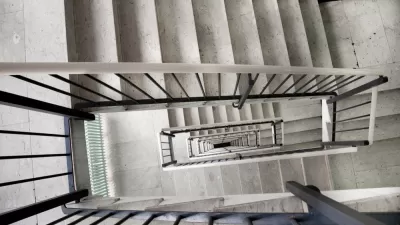One writer argues that single-staircase buildings solve an architectural problem and make buildings more interesting, but the political problem of the U.S. housing crisis goes much deeper.

The single-staircase building, prohibited in many U.S. cities due to fire safety regulations, has been getting a lot of attention lately as U.S. housing advocates look to loosening staircase regulations as one way to create more housing and lower construction costs. Planetizen has previously covered arguments in favor of single-staircase construction, whose proponents say it would improve housing affordability and encourage more ‘missing middle housing.’
Writing in The Nation, Kate Wagner argues that permitting single-staircase buildings is not the housing solution many think it is. Although a “good idea,” for Wagner, it is simply a design change that “fixes an architectural problem. There is little evidence as far as I can see that the schema will do anything to lower rents or fix urban inequality or anything else that would be so deeply transformative.”
Ultimately, for Wagner, the problem at the root of the housing crisis and of tragedies like the 2017 Grenfell Tower fire is “a housing market that is completely financialized and inherently predatory.” The drive to profit from housing as a commodity, Wagner argues, can’t be solved through design changes.
I would posit that rarely are buildings architectural failures—more often, they are social and political failures.
Wagner goes on, “Single-stair is not going to fix the housing crisis, because the housing crisis stems from an economic system in which housing is a commodity and a money-making scheme instead of a human right to shelter.” The key: “severing the connection between shelter and profit.”
FULL STORY: Single-Stair Layouts Are Not Going to Fix the Housing Crisis

Manufactured Crisis: Losing the Nation’s Largest Source of Unsubsidized Affordable Housing
Manufactured housing communities have long been an affordable housing option for millions of people living in the U.S., but that affordability is disappearing rapidly. How did we get here?

Americans May Be Stuck — But Why?
Americans are moving a lot less than they once did, and that is a problem. While Yoni Applebaum, in his highly-publicized article Stuck, gets the reasons badly wrong, it's still important to ask: why are we moving so much less than before?

Using Old Oil and Gas Wells for Green Energy Storage
Penn State researchers have found that repurposing abandoned oil and gas wells for geothermal-assisted compressed-air energy storage can boost efficiency, reduce environmental risks, and support clean energy and job transitions.

Greening Oakland’s School Grounds
With help from community partners like the Trust for Public Land, Oakland Unified School District is turning barren, asphalt-covered schoolyards into vibrant, green spaces that support outdoor learning, play, and student well-being.

California Governor Suspends CEQA Reviews for Utilities in Fire Areas
Utility restoration efforts in areas affected by the January wildfires in Los Angeles will be exempt from environmental regulations to speed up the rebuilding of essential infrastructure.

Native American Communities Prepare to Lead on Environmental Stewardship
In the face of federal threats to public lands and conservation efforts, indigenous groups continue to model nature-centered conservation efforts.
Urban Design for Planners 1: Software Tools
This six-course series explores essential urban design concepts using open source software and equips planners with the tools they need to participate fully in the urban design process.
Planning for Universal Design
Learn the tools for implementing Universal Design in planning regulations.
Heyer Gruel & Associates PA
City of Moreno Valley
Institute for Housing and Urban Development Studies (IHS)
City of Grandview
Harvard GSD Executive Education
Salt Lake City
NYU Wagner Graduate School of Public Service
City of Cambridge, Maryland





























